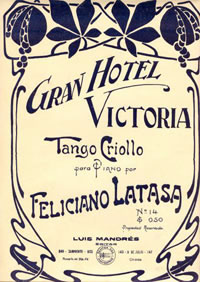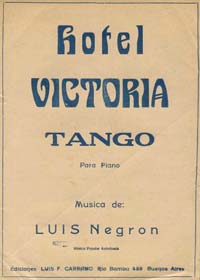By
Gran Hotel Victoria - “Gran Hotel Victoria”, an anonymous tango

here is a number of tangos whose origin is confusing and, in general, they are inspired in old light-hearted songs and popular airs. Those tangos may be catalogued as «anonymous tangos». For example here are two widely known: “Don Juan (El taita del barrio)” by Ernesto Ponzio and Juan Maglio’s “Siete palabras”. There are many more and the one we are going to talk about is one of these.
In the Historia del tango that we co-wrote with José Gobello and which was periodically published by several newspapers of the country around 1975-1978 we said about “Hotel Victoria”:
 «Mr. César Viale, in his book Estampas de mi tiempo, said that that tango was played for the first time in one of the well-known carnival balls of the Politeama (dancehall and later café in Buenos Aires at the corner of Corrientes and Paraná). But the historian from Córdoba, Efraín Bischoff, says a different thing. He affirms it is a tango from Córdoba which was composed by Feliciano Latasa for the opening on January 4, 1906 of the enlargement of the Gran Hotel Victoria which was run by Pascual Andruet on 133 San Martín Street in the city of Córdoba».
«Mr. César Viale, in his book Estampas de mi tiempo, said that that tango was played for the first time in one of the well-known carnival balls of the Politeama (dancehall and later café in Buenos Aires at the corner of Corrientes and Paraná). But the historian from Córdoba, Efraín Bischoff, says a different thing. He affirms it is a tango from Córdoba which was composed by Feliciano Latasa for the opening on January 4, 1906 of the enlargement of the Gran Hotel Victoria which was run by Pascual Andruet on 133 San Martín Street in the city of Córdoba».
We shall present a short biography of the composer or, maybe rather, alleged composer of the piece. Pianist and violinist, Latasa was born in San Sebastián —Guipúzcoa, Spain— on September 25, 1870 and settled in the city of Rosario, province of Santa Fe, at the dawn of the twentieth century. At that city he led the orchestra of the Sociedad España and the Orfeón Gallego.
When in Córdoba he appeared at the Club Democrático España and at the Roma and Victoria hotels leading his orchestra lined up by José Ferreras and Cristóbal Boday (violins), José Aguilar (flute), José Guisado (clarinet), Ernesto Di Blasi (trombone) and J. Macia Granja (bass). He composed the tango “Gran Hotel Victoria” (Hotel Victoria), the chotis “Carmencita”, the zarzuelas “Risas y lágrimas” and “Celeste”, and, according to Vicente Gesualdo, numerous dancehall pieces, chotis, mazurcas, polkas, waltzes, pas de quatre, etc. He died in Córdoba on September 18, 1906 when he was nearing age 36.
Coming back to the tango at issue, doubts about his author arose. According to Eduardo Stilman, «The early editions of this piece do not bear any signature while others are signed with the initials H. D.».
On October 20, 1924 Carmen Jiménez appearing at La borrachera del tango premiered “La payasa”, a tango whose lyrics were signed by the playwrights Elías Alippi and Carlos Schaeffer Gallo but which in fact had been written by J. Polidano. But curiously its melody was no other but the one of “Hotel Victoria”. It can be heard in the rendition that Ignacio Corsini recorded that same year, accompanied by José María Aguilar on guitar, Odeon 210 A. We don’t know any other recording with that title and that lyric.
 In the following decade —1932 to be precise—, a sheet music copy on whose front cover was written: “Hotel Victoria” appeared. Tango for piano by Luis Negrón. Publisher and printer Luis Filardi. Who this Mr. Negrón is? The only piece of information about him we have is a sheet music copy of the tango “El cebollero” with lyrics by Ángel Villoldo.
In the following decade —1932 to be precise—, a sheet music copy on whose front cover was written: “Hotel Victoria” appeared. Tango for piano by Luis Negrón. Publisher and printer Luis Filardi. Who this Mr. Negrón is? The only piece of information about him we have is a sheet music copy of the tango “El cebollero” with lyrics by Ángel Villoldo.
Much later —Bischoff told us—, the same sheet music «was copied by two Japanese composers, Midori Tagami and his niece Eri, for their song “Mizuiro No Koi” that the female singer Amachi made into a smash hit in the seventies».
It’s worthwhile saying that, besides the lyrics written by Polidano as “La payasa” the play included an anonymous stanza that said: «Mirá la china/ cómo se pinta/ color de tinta/ para pasear» (Look at the girl that uses a colorful make-up when she goes for a stroll) or this variant of the last line: «que da calor» (which make us hot) and words by Carlos Pesce in 1932 which were committed to disc by Ángel Vargas in 1945 with the orchestra led by Ángel D’Agostino, and Tita Merello accompanied by Carlos Figari in 1968.
But the thing does not end here. Then we should ask why did the signatures of H. D., Alippi-Schaeffer Gallo, Luis Negrón and the Japanese authors appear if the number belonged to Latasa? Probably because it didn’t.
The scholar of Rosario, Héctor Nicolás Zinni, wrote to us on June 10, 1988: «Latasa was for some time in this city. Then all of a sudden he went to the city of Córdoba for the carnival season and there he premiered the tango “Hotel Victoria”. There is no information about where he composed it, if here or in Córdoba. Even it is not known with certainty that the tango belonged to him, despite he had signed it (Latasa, I think, has no other tango composition). Somebody said that the tango was composed by a violinist based in Rosario named Alfredo Barone. When I knew about it I tried to find him. Finally I found him, but in Buenos Aires, because in his latter years the man was living there. We exchanged letters. He did not want to say anything by letter and he invited me to meet him and so he would clear out my doubts. I, for different reasons, was unable to go. Time passed and Barone died with his secret (if there was any)».
Furthermore Zinni, in a previous note for the Revista de Historia de Rosario in 1977 says:the violinist of Rosario Alfredo Barone would claim unsuccessfully having composed “Gran Hotel Victoria”».
Besides existing so many authors for a piece, there is a coincidence between the motifs of the first section of the tango and the third of Ángel Villoldo’s “Yunta brava”. Was it an anonymous melody?
Probably, because about this clue another evidence again appeared. When in 1979 we presented at the Café Tortoni the show Del tango andaluz al tango criollo in which Lola Hisado sang the Spanish examples and José Benzabath did the same with ours, after hearing Benzabath sing the anonymous stanza of “Hotel Victoria”, Lola surprised us after the show with these words: «There is a Spanish song with the same melody». She was alluding to the third section that, according to the Pesce’s text, says: “Hotel Victoria, vos que supiste/ lo que he llorado en mi soledad”.
Our conclusion was that it would be some anonymous Spanish tune that would have been taken by Latasa or maybe Barone, God knows who. On the other hand, perhaps the whole piece is anonymous, since the first section is a typical milonga introduction for guitar and it also appears, as was said above, in “Yunta brava” while the remaining three present an unmistakable air of Andalusian tango.
In sum, Latasa or Barone or whoever, must have taken some popular airs for composing the tango.
Lastly, as for the hotel that inspired its name —not withstanding its author and the date of the composition—, undoubtedly, its name was given by Latasa to fulfill his show business engagement at the celebration at the end of the works for remodeling the hotel of Córdoba.
Some recordings of "Gran Hotel Victoria":
Orchestra Vicente Greco (1910)
Estudiantina Centenario Dir: Vicente Abad (1910)
Orchestra Roberto Firpo (1925)
Orchestra Francisco Canaro (1935)
Orchestra Juan D'Arienzo, (1935)
OrchestraÁngel D'Agostino, with Ángel Vargas (1945)
Quartet Roberto Firpo (1948)
Orchestra Juan D'Arienzo (1948)
Quartet Juan Cambareri (1949)
Conjunto Domingo Rulio “Pa’que Bailen Los Muchachos”
Orchestra Joaquín Do Reyes (1952)
Orchestra Florindo Sassone (1959)
Quintet Pirincho Dir: Francisco Canaro (1959)
Quintet Real (1961)
Orchestra Juan D'Arienzo (1966)
Orchestra Carlos Figari, with Tita Merello (1968)
Quartet Héctor Stamponi (1975)
Orchestra Jorge Dragone
Duet Salgan-De Lío (1976)
Sextet Mayor (1977)
Duet Salgan-De Lío (1988)
Sextet Norberto Ramos
Sextet Tango Concertino (1995)
Nuevo Quinteto Real (1999)
Quintet Quique Lanoo “Quinteto De Maestros”
Orchestra Jorge Arduh (1999)
Quintet Pablo Mainetti, with Rubén Olmos (2000)
Orchestra Omar Torres (2003)
Quartet Tango Desatado (2004)